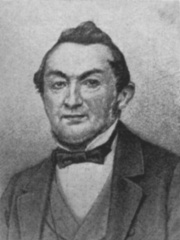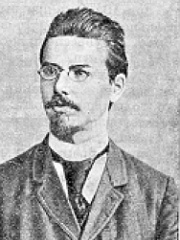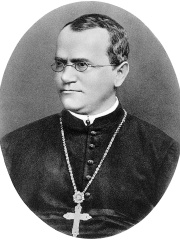
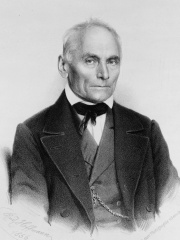
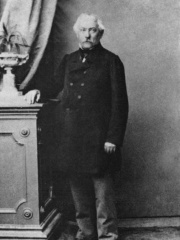
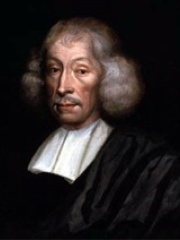
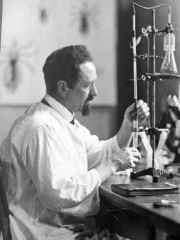
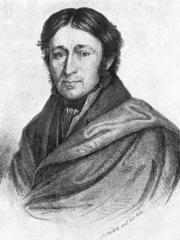
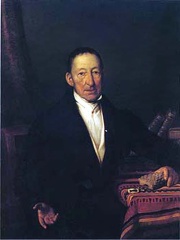
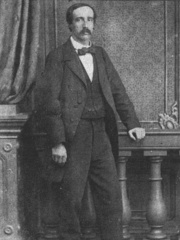
The Most Famous
BIOLOGISTS from Czechia
This page contains a list of the greatest Czech Biologists. The pantheon dataset contains 1,097 Biologists, 15 of which were born in Czechia. This makes Czechia the birth place of the 12th most number of Biologists behind Poland, and Netherlands.
Top 10
The following people are considered by Pantheon to be the top 10 most legendary Czech Biologists of all time. This list of famous Czech Biologists is sorted by HPI (Historical Popularity Index), a metric that aggregates information on a biography's online popularity. Visit the rankings page to view the entire list of Czech Biologists.

1. Gregor Mendel (1822 - 1884)
With an HPI of 85.69, Gregor Mendel is the most famous Czech Biologist. His biography has been translated into 114 different languages on wikipedia.
Gregor Johann Mendel OSA (; German: [ˈmɛndl̩]; Czech: Řehoř Jan Mendel; 20 July 1822 – 6 January 1884) was an Austrian biologist, meteorologist, mathematician, Augustinian friar and abbot of St. Thomas' Abbey in Brno (Brünn), Margraviate of Moravia. Mendel was born in a German-speaking family in the Silesian part of the Austrian Empire (today's Czech Republic) and gained posthumous recognition as the founder of the modern science of genetics. Though farmers had known for millennia that crossbreeding of animals and plants could favor certain desirable traits, Mendel's pea plant experiments conducted between 1856 and 1863 established many of the rules of heredity, now referred to as the laws of Mendelian inheritance. Mendel worked with seven characteristics of pea plants: plant height, pod shape and color, seed shape and color, and flower position and color. Taking seed color as an example, Mendel showed that when a true-breeding yellow pea and a true-breeding green pea were cross-bred, their offspring always produced yellow seeds. However, in the next generation, the green peas reappeared at a ratio of 1 green to 3 yellow. To explain this phenomenon, Mendel coined the terms "recessive" and "dominant" in reference to certain traits. In the preceding example, the green trait, which seems to have vanished in the first filial generation, is recessive, and the yellow is dominant. He published his work in 1866, demonstrating the actions of invisible "factors"—now called genes—in predictably determining the traits of an organism. The actual genes were only discovered in a long process that ended in 2025 when the last three of the seven Mendel genes were identified in the pea genome. The profound significance of Mendel's work was not recognized until the turn of the 20th century (more than three decades later) with the rediscovery of his laws. Erich von Tschermak, Hugo de Vries and Carl Correns independently verified several of Mendel's experimental findings in 1900, ushering in the modern age of genetics.

2. Jan Evangelista Purkyně (1787 - 1869)
With an HPI of 70.67, Jan Evangelista Purkyně is the 2nd most famous Czech Biologist. His biography has been translated into 43 different languages.
Jan Evangelista Purkyně (Czech: [ˈjan ˈɛvaŋɡɛˌlɪsta ˈpurkɪɲɛ] ; also written Johann Evangelist Purkinje) (17 or 18 December 1787 – 28 July 1869) was a Czech anatomist and physiologist. In 1839, he coined the term "protoplasma" for the fluid substance of a cell. He was one of the best known scientists of his time. Such was his fame that when people from outside Europe wrote letters to him, all that they needed to put as the address was "Purkyně, Europe".

3. Heinrich Wilhelm Schott (1794 - 1865)
With an HPI of 63.05, Heinrich Wilhelm Schott is the 3rd most famous Czech Biologist. His biography has been translated into 25 different languages.
Heinrich Wilhelm Schott (7 January 1794 – 5 March 1865) was an Austrian botanist. He is known for his extensive work on aroids (Araceae).

4. Georg Joseph Kamel (1661 - 1706)
With an HPI of 62.44, Georg Joseph Kamel is the 4th most famous Czech Biologist. His biography has been translated into 19 different languages.
Georg Joseph Kamel (German: [ˈkaːml̩]; Latin: Georgius Josephus Camellus; Czech: Jiří Josef Kamel; Spanish: Jorge Camel; 12 April 1661 – 2 May 1706) was a Jesuit missionary, pharmacist and naturalist known for producing the first comprehensive accounts of Philippine flora and fauna and for introducing Philippine nature to the European learned world. A number of Kamel's treatises were published in the Philosophical Transactions, while his descriptions of Philippine flora appeared as an appendix to the third volume of John Ray's Historia Plantarum.
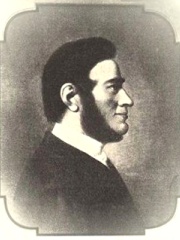
5. Carl Borivoj Presl (1794 - 1852)
With an HPI of 62.16, Carl Borivoj Presl is the 5th most famous Czech Biologist. His biography has been translated into 25 different languages.
Carl Borivoj Presl (Czech: Karel Bořivoj Presl; 17 February 1794 – 2 October 1852) was a Czech botanist. The standard author abbreviation C.Presl is used to indicate this person as the author when citing a botanical name.

6. Rudolf Weigl (1883 - 1957)
With an HPI of 61.28, Rudolf Weigl is the 6th most famous Czech Biologist. His biography has been translated into 25 different languages.
Rudolf Stefan Jan Weigl (2 September 1883 – 11 August 1957) was a Polish biologist, physician and inventor, known for creating the first effective vaccine against epidemic typhus. He was nominated for the Nobel Prize in Medicine each year between 1930 and 1934, and from 1936 to 1939. Weigl worked during the Holocaust to save the lives of countless Jews by developing the vaccine for typhus and providing shelter to protect those suffering under the Nazi Germans in occupied Poland. For his contributions, he was named a Righteous Among the Nations in 2003.

7. Jan Svatopluk Presl (1791 - 1849)
With an HPI of 60.46, Jan Svatopluk Presl is the 7th most famous Czech Biologist. His biography has been translated into 25 different languages.
Jan Svatopluk Presl (4 September 1791 – 6 April 1849) was a Czech natural scientist. He was the brother of botanist Carl Borivoj Presl (1794–1852). The Czech Botanical Society commemorated the two brothers by naming its principal publication Preslia (founded in 1914). He is the author of Czech scientific terminology of various branches of science, including the Czech chemical nomenclature. He was the co-author of an important Czech taxonomic work, O Přirozenosti Rostlin. The brothers co-edited the exsiccata series Vegetabilia cryptogamica Boëmiae collecta a Joanne et Carolo Presl.

8. Kaspar Maria von Sternberg (1761 - 1838)
With an HPI of 60.09, Kaspar Maria von Sternberg is the 8th most famous Czech Biologist. His biography has been translated into 20 different languages.
Count Kaspar Maria von Sternberg (also: Caspar Maria, Count Sternberg, German: Kaspar Maria Graf von Sternberg, Czech: Kašpar Maria hrabě ze Šternberka; 6 January 1761 – 20 December 1838) was a Bohemian aristocrat, theologian, mineralogist, geognost, entomologist and botanist. He is known as the "Father of Paleobotany".

9. August von Pelzeln (1825 - 1891)
With an HPI of 58.47, August von Pelzeln is the 9th most famous Czech Biologist. His biography has been translated into 17 different languages.
August von Pelzeln (10 May 1825, Prague – 2 September 1891 in Oberdöbling) was an Austrian ornithologist. He was a grandson to novelist Karoline Pichler (1769-1843). He studied at the University of Vienna, later working as an assistant under helminthologist Karl Moriz Diesing (1800-1867) in the Hof-Naturalien-Cabinet (from 1851). In 1857 he acquired curatorial duties formerly held by Johann Jakob Heckel (1790-1857), and subsequently became in charge of the bird (1857) and mammal (1869) collections. He worked on the birds collected by Johann Natterer in Brazil (343 species). He was forced to retire from the museum due to ill health, and died at Oberdöbling near Vienna. Some birds described by Pelzeln are the orange-breasted thornbird, the spot-winged antbird, the red-legged tinamou, the white-throated tinamou, the short-billed leaftosser, the yellow-margined flatbill and the New Zealand rockwren. His name is associated with Pelzeln's tody-tyrant (Hemitriccus inornatus). Gustav Hartlaub (1814-1900) named the Madagascar grebe (Tachybaptus pelzelnii) in his honor; Otto Finsch (1839-1917) named the Pohnpei starling (Aplonis pelzelni) after Pelzeln.

10. Ferdinand Albin Pax (1858 - 1942)
With an HPI of 58.23, Ferdinand Albin Pax is the 10th most famous Czech Biologist. His biography has been translated into 16 different languages.
Ferdinand Albin Pax (26 July 1858 – 1 March 1942) was a German botanist specializing in spermatophytes. A collaborator of Adolf Engler, he wrote several monographs and described several species of plants and animals from Silesia and the Carpathians. He was a professor at Wrocław University from 1893. His son Ferdinand Albert Pax (1885–1964) was a noted zoologist.
People
Pantheon has 15 people classified as Czech biologists born between 1661 and 1883. Of these 15, none of them are still alive today. The most famous deceased Czech biologists include Gregor Mendel, Jan Evangelista Purkyně, and Heinrich Wilhelm Schott.
Deceased Czech Biologists
Go to all RankingsGregor Mendel
1822 - 1884
HPI: 85.69
Jan Evangelista Purkyně
1787 - 1869
HPI: 70.67
Heinrich Wilhelm Schott
1794 - 1865
HPI: 63.05
Georg Joseph Kamel
1661 - 1706
HPI: 62.44
Carl Borivoj Presl
1794 - 1852
HPI: 62.16
Rudolf Weigl
1883 - 1957
HPI: 61.28
Jan Svatopluk Presl
1791 - 1849
HPI: 60.46
Kaspar Maria von Sternberg
1761 - 1838
HPI: 60.09
August von Pelzeln
1825 - 1891
HPI: 58.47
Ferdinand Albin Pax
1858 - 1942
HPI: 58.23
Franz Xaver Fieber
1807 - 1872
HPI: 57.66
Friedrich Reinitzer
1857 - 1927
HPI: 57.23
Overlapping Lives
Which Biologists were alive at the same time? This visualization shows the lifespans of the 13 most globally memorable Biologists since 1700.

